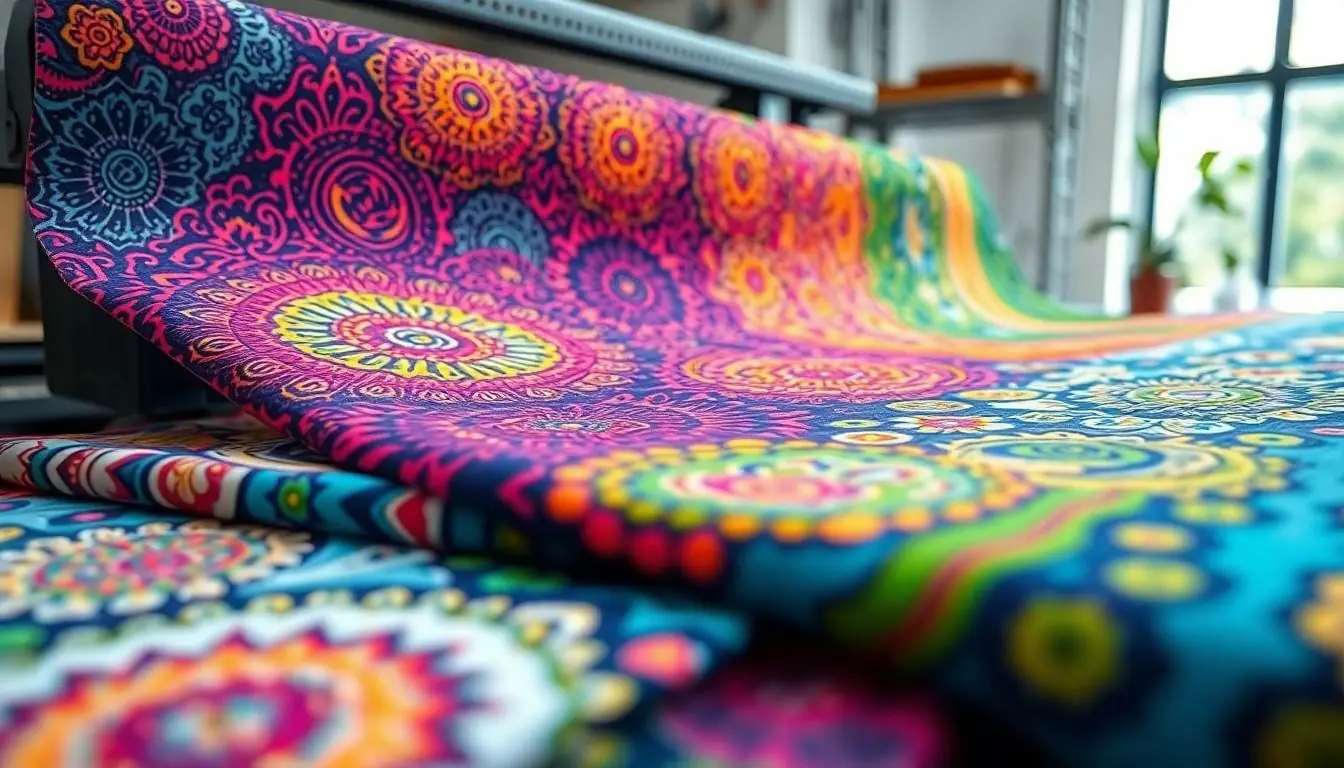In a world where fashion often comes at the expense of the planet, sustainable fabric printing technology is the superhero we didn’t know we needed. Imagine a realm where vibrant colors pop without the guilt of harming Mother Earth. That’s right! This groundbreaking technology is turning the tide on traditional printing methods that could make even the most eco-conscious person cringe.
Table of Contents
ToggleOverview of Sustainable Fabric Printing Technology
Sustainable fabric printing technology represents a pivotal shift in the textile industry. This method leverages eco-friendly inks made from natural materials, minimizing environmental impact. Additionally, it utilizes processes that consume less water and energy compared to traditional techniques. The dyeing processes often adopt waterless systems, greatly reducing water usage.
Digital printing plays a key role in sustainability. This technique allows for precise ink application, reducing waste and chemical runoff. Moreover, innovations like reactive and pigment inks enhance color vibrancy while maintaining ecological balance. Using these inks, producers can create textiles that meet high aesthetic standards without compromising environmental health.
Consumer awareness drives advancements in sustainable practices. Individual preferences increasingly lean towards eco-conscious products, pushing brands to adopt these technologies. Companies that implement sustainable fabric printing signal their commitment to environmental stewardship. Aligning with consumer values not only attracts buyers but also fosters loyalty.
Research supports the effectiveness of sustainable technologies. Studies demonstrate that manufacturers can achieve similar or superior quality with reduced environmental harm. For example, water-based inks produce vibrant prints while adhering to stringent environmental regulations.
This evolution in fabric printing also challenges established processes. By replacing harmful chemicals with safer alternatives, producers help restore ecosystems damaged by traditional textile manufacturing. The integration of biodegradable and recyclable materials further underscores this commitment to sustainability.
In sum, sustainable fabric printing technology appeals to eco-conscious consumers and symbolizes a transformative movement in the fashion industry. Its environmental benefits and technological advancements mark a significant progress towards a greener future.
Benefits of Sustainable Fabric Printing

Sustainable fabric printing offers two main benefits: a reduced environmental impact and economic advantages.
Environmental Impact
Sustainable fabric printing minimizes ecological harm by utilizing eco-friendly inks and processes. These inks, often derived from natural materials, limit harmful chemical use. Water consumption decreases significantly due to digital printing methods, which only apply ink where needed. Waste reduction becomes evident as manufacturers optimize production steps, thus preventing excess runoff and pollution. Biodegradable and recyclable materials replace traditional substances, further supporting sustainability. Research indicates less energy usage in sustainable printing compared to conventional methods, reinforcing its positive role in combating climate change.
Economic Advantages
Sustainable fabric printing presents several economic benefits for manufacturers and consumers. Lower production costs arise from reduced waste and efficient processes. Brands gain a competitive edge by appealing to eco-conscious consumers who prioritize sustainability. Studies show that incorporating sustainable practices can lead to increased customer loyalty, boosting long-term profitability. Innovation in printing technologies also drives new market opportunities, resulting in diversified product offerings. Additionally, cost savings on raw materials and energy consumption enable companies to invest in further sustainable initiatives.
Types of Sustainable Fabric Printing Methods
Sustainable fabric printing encompasses various innovative methods, enhancing both quality and environmental performance. Two key techniques stand out: digital printing and the use of eco-friendly inks.
Digital Printing
Digital printing utilizes inkjet technology to apply designs directly onto fabric. It enables precise color application, resulting in reduced ink usage and waste. This method minimizes water consumption significantly, consuming up to 95% less than traditional printing methods. Efficiency also improves since digital printing eliminates the need for screens or plates, streamlining the production process. Furthermore, manufacturers can produce smaller runs economically, catering to diverse consumer preferences without the burden of overproduction.
Eco-Friendly Inks
Eco-friendly inks play a critical role in sustainable fabric printing. Derived from natural or non-toxic materials, these inks avoid harmful chemicals found in conventional counterparts. Using plant-based pigments becomes increasingly common, enhancing color vibrancy without environmental harm. Additionally, many eco-friendly inks are biodegradable, ensuring that they break down over time. Compatibility with various fabrics makes these inks versatile, allowing brands to maintain high quality while adhering to sustainable practices. By opting for eco-friendly inks, manufacturers not only protect the environment but also appeal to growing eco-conscious consumer demands.
Challenges in Implementing Sustainable Practices
Sustainable fabric printing technology faces several hurdles in its widespread adoption. Key challenges include cost barriers and the need for increased consumer awareness.
Cost Barriers
Cost barriers significantly impact the implementation of sustainable practices. Traditional printing methods often require lower initial investment compared to sustainable alternatives. Switching to eco-friendly inks and digital printing technology entails higher upfront costs for manufacturers. Additionally, specialized equipment for digital printing involves substantial financial outlay. Many brands experience difficulty justifying these costs, especially small businesses with limited budgets. While long-term savings and environmental benefits exist, the immediate expenses deter some companies from adopting these sustainable practices. Therefore, financial considerations play a crucial role in the decision-making process regarding fabric printing technologies.
Consumer Awareness
Consumer awareness poses another challenge for sustainable fabric printing. While awareness of environmental issues is increasing, many consumers remain uninformed about the benefits of sustainable printing methods. Education about eco-friendly inks and water-saving techniques is essential for driving demand. Brands that successfully communicate their sustainable practices often gain a competitive edge. Furthermore, the lack of standardized labeling or certifications for sustainable products creates confusion. As consumers seek greener options, marketers must bridge the gap between sustainable practices and consumer understanding. Consequently, raising awareness about sustainable fabric printing methods becomes vital for market growth.
Future Trends in Sustainable Fabric Printing Technology
Innovations in sustainable fabric printing technology are on the rise, showcasing promising developments for the textile industry. Increased investment in research and development drives advancements, enhancing the quality and efficiency of eco-friendly printing methods. Brands are focusing on biodegradable and recyclable materials, which align with growing consumer demand for sustainable products.
Emerging technologies like 3D printing present new opportunities in fabric production. These technologies allow for material conservation with precise patterns, reducing waste significantly. Integration of artificial intelligence and machine learning optimizes printing processes, ensuring better utilization of resources and minimizing errors.
Consumers play a crucial role in shaping these trends through their preferences. Eco-conscious buyers are pushing brands to adopt more sustainable practices, prompting a shift in manufacturing standards. Surveys indicate that 73% of consumers prefer brands committed to sustainability, underscoring the importance of eco-friendly innovations.
Printing processes are becoming increasingly digital and efficient. Recent developments in water-based inks resolve environmental concerns associated with traditional solvents. Digital technologies not only reduce water consumption by up to 95% but also allow for greater customization, catering to diverse consumer tastes.
Collaboration between brands and startups is fostering innovation in sustainable practices. Partnerships often lead to the sharing of knowledge and resources, accelerating the implementation of eco-friendly technologies. This synergy enables brands to stay competitive while enhancing their sustainability credentials.
Sustainability certifications are expected to become more standardized in the coming years. Clear labeling can help consumers make informed choices, enhancing overall market transparency. As awareness grows, brands that adopt sustainable fabric printing technologies can differentiate themselves and build stronger customer loyalty.
Sustainable fabric printing technology stands at the forefront of a transformative shift in the fashion industry. By prioritizing eco-friendly practices and innovative methods, it aligns with the growing consumer demand for sustainability. The integration of digital printing and natural inks not only enhances the quality of products but also significantly reduces environmental impact.
As brands continue to embrace these advancements, they’ll likely see increased customer loyalty and new market opportunities. Overcoming challenges like cost barriers and consumer awareness will be crucial for widespread adoption. With ongoing research and collaboration, the future of sustainable fabric printing looks promising, paving the way for a greener and more responsible fashion landscape.




